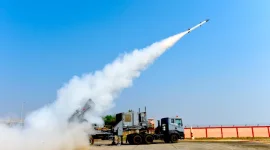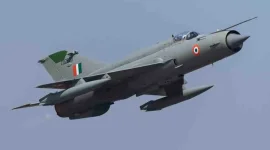- Views: 3K
- Replies: 9
India's domestically developed air defence systems, the Akash Surface-to-Air Missile (SAM) and the Medium-Range Surface-to-Air Missile (MRSAM), are proving to be vital assets in the nation's comprehensive air defence strategy.
These systems, engineered by the Defence Research and Development Organisation (DRDO) with industry partners Bharat Dynamics Limited (BDL) and Bharat Electronics Limited (BEL), have reportedly shown impressive capabilities in recent engagements, notably during recent clashes between India and Pakistan.
While comparisons are often drawn with renowned international systems like Israel's Iron Dome and David’s Sling, or the American Patriot missile system, questions about their relative effectiveness, particularly against mass drone and missile assaults, are common.
However, recent performance data suggests that India's indigenous systems offer comparable, and in some specific scenarios like saturated attacks, superior accuracy and resilience, alongside significant cost benefits.
Understanding India's Indigenous Shield
The Akash SAM is a mobile, medium-range missile system designed to counter a wide array of aerial threats including fighter aircraft, drones, cruise missiles, and air-launched missiles. It can engage targets up to 25-45 kilometres away and at altitudes up to 20 kilometres.A key feature is its Rajendra phased-array radar, capable of tracking as many as 64 targets simultaneously and guiding 12 missiles at once.
Enhanced versions like Akash-1S, Akash Prime, and the newer Akash-NG (New Generation) come with advanced indigenous seekers and an extended strike range of up to 70-80 kilometres for the Akash-NG.
Complementing the Akash is the MRSAM system, a collaborative effort between India and Israel. It is designed to intercept medium-range aerial threats, including aircraft, missiles, and drones, at distances between 70 and 100 kilometres and at higher altitudes.
Both the Indian Air Force and the Indian Army have deployed the MRSAM, adding another crucial layer to India's air defence network.
Performance in Recent Operations
According to reports, during "Operation Sindoor" in May 2025, which was initiated following a terror attack in Pahalgam, both Akash and MRSAM systems were instrumental in neutralising drone and missile attacks from Pakistan.India's Director General of Military Operations (DGMO) reportedly lauded the Akash's performance as "stellar," specifically highlighting its success in intercepting multiple targets, including advanced kamikaze drones, over Amritsar and other border regions.
Further evidence of the Akash system's capability was demonstrated during the Indian Air Force's "Astrashakti" exercise in December 2023. In this exercise, a single Akash unit successfully engaged four unmanned aerial targets simultaneously, even when these targets were in close formation and then split to attack from different directions.
A Look at Israeli and American Systems
Globally recognized Israeli air defence systems include the Iron Dome, effective against short-range rockets, artillery, and mortars (RAM) with a range of 4-70 km, and David’s Sling, which targets medium- to long-range threats (40-300 km). The Iron Dome is noted for a high success rate, reportedly 85-90%, against rockets.The United States’ Patriot Advanced Capability-3 (PAC-3) system is a long-range, high-altitude defence mechanism against tactical ballistic missiles, cruise missiles, and aircraft, with a range extending up to 180 km.
However, Patriot's effectiveness in dealing with saturated attacks, particularly by low-cost drones, has seen mixed results. For example, during Houthi drone and missile attacks against Saudi Arabia between 2019 and 2021, the system reportedly faced challenges in effectively intercepting low-flying drones.
While these Israeli and American systems feature highly advanced radar (such as the EL/M-2084 MMR for Iron Dome and AN/MPQ-53 for Patriot) and sophisticated interceptor missiles, their operational costs are substantial.
An Iron Dome interceptor can cost between $50,000 and $100,000, while a single Patriot missile is estimated at $2 million to $4 million. These costs can limit their widespread deployment against large-scale attacks involving numerous inexpensive threats like drone swarms.
Indian Systems: Effectiveness in Saturated Attacks
Recent combat situations, especially during "Operation Sindoor," appear to underscore the strengths of India’s Akash and MRSAM systems when facing dense drone and missile barrages.On the night of May 8-9, 2025, it was reported that Pakistan launched over 50 swarm drones and missiles towards 15 Indian military and civilian sites. India’s layered air defence, incorporating Akash, MRSAM, and the Russian S-400 system, reportedly neutralised these threats effectively.
Military sources indicated that Akash intercepted multiple drones and missiles with high precision, preventing damage to critical infrastructure.
In contrast, even highly effective systems like the Iron Dome have reportedly been challenged by high-volume attacks. During intense Hamas salvos in 2023, interception rates reportedly dipped below 80% when the system was saturated.
Similarly, the Patriot system's deployment in Saudi Arabia highlighted difficulties against low-flying drones that can exploit radar coverage gaps, often requiring multiple costly interceptors for a single, inexpensive target.
The Akash system's reported kill probability of 88% with the first missile and 99% with a second missile is claimed to rival or even exceed that of the Iron Dome and Patriot in certain scenarios. Its demonstrated ability in Exercise Astrashakti to engage four targets with one firing unit indicates strong performance against swarm tactics.
The upcoming Akash-NG, featuring an extended range and an Active Electronically Scanned Array (AESA) radar, is expected to further bolster its capacity against stealthy and high-speed threats, potentially offering advantages over the Iron Dome's primarily short-range focus.
Indigenous Innovation and Cost Advantages
India’s air defence systems benefit from indigenous developments tailored to regional threat perceptions.The Akash-1S and Akash Prime variants are equipped with locally developed active radio frequency (RF) seekers, enhancing their accuracy against agile targets like drones and cruise missiles.
The Rajendra radar’s proficiency in tracking low-flying targets also gives Akash an edge in complex terrains, a challenge for some Western systems whose radars have reportedly struggled with low-altitude threats in cluttered ground environments.
The MRSAM, while leveraging Israeli technology, has been customised for Indian operational needs. It offers accuracy comparable to systems like David’s Sling, using an active radar homing seeker for precise guidance in the final phase of interception.
This feature reduces its reliance on ground-based radar during the terminal stage, making it more resilient to electronic jamming compared to systems like the Patriot, which use semi-active radar homing for some interceptors.
While Israeli and American systems generally maintain an edge in overall technological sophistication and network integration (benefiting from links with NATO and Israeli command structures), India's Integrated Air Command and Control System (IACCS) is continuously being upgraded.
A significant advantage for Indian systems is their cost-effectiveness. An Akash missile is estimated to cost around $500,000, considerably less than the Patriot’s $2-4 million interceptors or even the Iron Dome’s $50,000-$100,000 Tamir missiles. This affordability enables India to deploy a denser air defence network capable of absorbing large-scale attacks without incurring prohibitive expenses.
Furthermore, the high indigenous content in the Akash system (reportedly 82%, with projections to reach 93% by 2026-27) reduces dependence on foreign suppliers, enhancing strategic autonomy. This contrasts with systems like the Patriot, which rely on U.S. logistical support. This indigenous focus is a key element in India's strategy for a self-reliant and resilient national defence.


